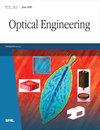利用距离向量为室内多输入多输出可见光通信建立基于接收信号强度的自适应定位和信道状态信息估计模型
IF 1.1
4区 工程技术
Q4 OPTICS
引用次数: 0
摘要
摘要我们为室内多输入多输出(MIMO)可见光通信(VLC)提出了一种使用距离矢量的自适应定位和信道状态信息(CSI)估计模型。在正常情况下,接收器(Rx)需要所有信道(由多个发射器(Tx)和多个 Rx 组成)的 CSI 来恢复原始数据,并需要从 Tx(即发光二极管(LED))获得的接收信号强度(RSS)来预测 Rx 的位置。带有 CSI 的信标(或先导信号 (PS))会定期从每个 LED 发射到多输入多输出 Rx,以构建 CSI 矩阵并测量 RSS。然而,在异常情况下,来自一个或多个 Tx 的 PS 可能会因阴影而无法到达 Rx,从而导致定位和数据恢复失败。为解决这一问题,所提出的模型可使 Rx 根据 Rx 的距离矢量构建预测其位置,而无需所有 PS。针对两种用户移动情况(即格子移动和随机方向移动)进行的模拟显示,定位误差分别为 0.1 和 0.2 米。根据预测的位置,MIMO VLC 能够满足 CSI 矩阵的要求,并以极低的误码率协助 Rx 恢复传输数据。本文章由计算机程序翻译,如有差异,请以英文原文为准。
Adaptive received signal strength-based localization and channel state information estimation model for indoor multiple-input multiple-output visible light communication using the distance vector
Abstract. We propose an adaptive localization and channel state information (CSI) estimation model using the distance vector for indoor multiple-input multiple-output (MIMO) visible light communication (VLC). Under normal conditions, receivers (Rxs) require the CSI of all channels [formed by multiple transmitters (Txs) and multiple Rxs] to recover the original data, and the received signal strength (RSS) obtained from Txs, i.e., light-emitting diodes (LEDs) to predict the Rx’s location. A beacon [or pilot signal (PS)] with CSI is periodically broadcasted from each LED to MIMO Rxs for constructing the CSI matrix and measuring the RSS. However, in an abnormal condition, PSs from one or multiple Txs might not reach Rxs due to shadowing, thus resulting in a failure in positioning and data recovery. To combat this, the proposed model enables the Rx to predict its location without the need for all PSs based on the construction of the distance vectors at Rx. Simulations conducted for two scenarios of user’s mobility, i.e., lattice and random direction mobility, show a low positioning error of ∼0.1 and 0.2 m, respectively. Based on predicted positions, MIMO VLC is capable of fulfilling the CSI matrix and assists the Rx in recovering transmitted data with a very low bit error rate.
求助全文
通过发布文献求助,成功后即可免费获取论文全文。
去求助
来源期刊

Optical Engineering
工程技术-光学
CiteScore
2.70
自引率
7.70%
发文量
393
审稿时长
2.6 months
期刊介绍:
Optical Engineering publishes peer-reviewed papers reporting on research and development in optical science and engineering and the practical applications of known optical science, engineering, and technology.
 求助内容:
求助内容: 应助结果提醒方式:
应助结果提醒方式:


